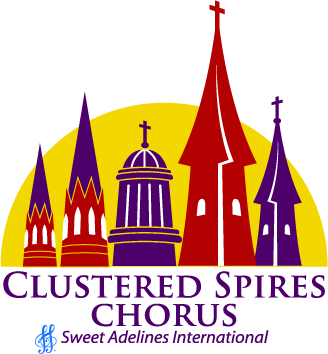Barbershop Music
What Is Barbershop?
Barbershop is a style of music which is sung a cappella in 4 parts with close harmonies. One person to each part creates a quartet. If there are multiple people to each part, the ensemble is called a chorus. Some choruses have fewer than 20 members, and others have over 100! Our chorus has just over 20 members, which is the perfect size to balance music quality and merriment!
Distinctive Sound
In Barbershop, the notes are tuned a little differently from the way a piano or other pitched instrument is tuned. The combination of these notes actually creates additional notes called overtones. Overtones cause the ringing sound characteristic to barbershop and send chills through everyone. You'll know it when you feel it!
For a detailed, somewhat technical explanation of this, visit the Barbershop music article on Wikipedia
The Four Voice Parts
Each of the 4 vocal parts has an important role in the sound of barbershop:
Lead - Sings the melody. In women's barbershop, the range is from A below middle to C to C above middle C.
Tenor - Sings harmony above the lead. Unlike the soprano of an SATB choir, the tenor sings harmony and has a light, ringing voice.
Bass - Sings the bottommost harmony, like the bass in a traditional SATB choir. In women's barbershop, sings as low as E-flat below middle C.
Baritone - Sings the note that completes the chord. Has roughly the same range as the lead, frequently crossing voices on any particular chord.
Someone will help you figure out what voice part is best for you the first time you sing with us.
How We Learn the Music
We learn by reading sheet music and by listening to practice tapes. Some use one or the other depending on their own preferences, and most use both tools to practice.
The sheet music (also called a score) is notated like so:

Regardless of whether you learn by reading music or listening and repeating, a little practice every day is the best way to learn!
Glossary
A cappella (AH cahPELah) [a kap'pɛl'la] - literally "In the manner of the chapel" - Music sung without accompaniment, as the tradition was in the church or chapel centuries ago.
Close harmonies:

Open harmonies

These are the same chord, but one has notes much closer together than the other. The resulting sounds have very different qualities.
SATB - Soprano Alto Tenor Bass - The traditional 4-part choir or chorus, with voices listed by range from the top down. (Barbershop voice parts written in the same fashion would be Tenor Lead Baritone Bass)

